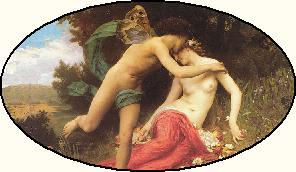Spadina Literary Review — edition 5 page 07
re verse
Albert and Flora: the Latest News
by Ian Allaby
I’m guessing it’s been ages since you heard word of Albert and Flora. Last anyone saw, Albert was high-tailing it into the woods. And Flora — well, she went out of her mind. But who wouldn’t? Few protagonists anywhere have labored under such a burden of allegory: Flora = Spring, Flora = Nature, Flora = Acadia, Flora = the New World, Flora = Albert’s bride-to-be, it’s a wonder she found time. And I regret adding another one, but eventually we have to face up: Flora = Lady X.
You do remember Albert and Flora, right? The ruined fiancés in “The Rising Village”? The poem Oliver Goldsmith wrote in Halifax in the 1820s? Anyone?

Flora the spring goddess meets Zephyr the wind god
(Wm. Bouguereau, 1875)
What’s that? No, you’re thinking of the other Oliver Goldsmith, the British one, the famous one, Doctor Goldsmith we’ll call him, the one who hobnobbed with Doctor Johnson and other 18th-century literati and got a plaque in Westminster Abbey.
No, I’m talking about our Oliver Goldsmith, who is obviously less famous.
The British Dr. Goldsmith, you see, had a nephew named Henry, who, being broke, joined the army and sailed to America in 1776 to suppress a rebellion. The rebels having won, Henry moved his family to St. Andrews in New Brunswick, a Loyalist colony newly carved from old Acadia. That’s where our Oliver was born, in 1794. He was Dr. Goldsmith’s grand-nephew and bore the same name.
Oliver, our Oliver, spent most of his life in the employ of the British Empire, working for the Commissariat, the army’s civilian-staffed supply department. For a few years within that staid career he wrote poetry, principally a long narrative poem, “The Rising Village,” which many critics consider an exercise in imperial/colonial boosterism. They think Oliver is a stuffed shirt. But in the midst of Oliver’s poem what takes you by surprise is the fervid so-called “Albert and Flora” sequence, a tale of passion, betrayal and guilt, that casts a lugubrious shadow across the sunny picture you think Oliver is trying to paint in the 'container' poem. Why on earth did he put that sequence in there? "Albert and Flora" is one reason some modern-day critics view Oliver as a man of crafty nuances and hidden messages. You have kept tuned to that debate, haven’t you?